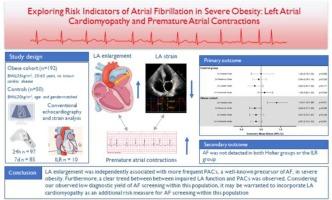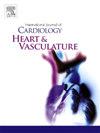Exploring risk Indicators of atrial fibrillation in severe Obesity: Left atrial cardiomyopathy and premature atrial contractions
IF 2.5
Q2 CARDIAC & CARDIOVASCULAR SYSTEMS
引用次数: 0
Abstract
Background
Although obesity is a major risk factor for atrial fibrillation (AF), its mechanisms and the diagnostic yield of AF screening in severe obesity is unclear. This study aims to enhance our comprehension of AF susceptibility in severe obesity by investigating associations between left atrial (LA) cardiomyopathy and premature atrial contractions (PACs) and to explore the diagnostic yield of AF screening.
Methods
This cross-sectional study included a total of 192 subjects aged 35–65 years with a BMI ≥ 35 kg/m2, alongside 50 non-obese controls, both without known cardiac disease. Prolonged heart rhythm registration was done with either 24-hours (n = 147) or 7-day Holter monitoring (n = 75) or an implantable loop recorder (ILR) (n = 10). Furthermore, we performed conventional transthoracic echocardiography and strain analyses.
Results
In the obese cohort, LA enlargement was independently associated with PAC frequency. Each SD increment (10 ml/m2) of LA volume index corresponded with a 46 % increase in PACs. An increase of each SD (10 %) LA reservoir strain was associated with a decrease of 16 % in PAC frequency. There was no association found between LA cardiomyopathy and PACs in the control group. AF was not detected in any subject.
Conclusion
LA enlargement was independently associated with more frequent PACs in severe obesity, a well-known AF precursor. There was a noticeable trend suggesting a relation between impaired LA function and PACs. Considering our observed low diagnostic yield of AF screening within this population, further investigation is needed to determine whether incorporating LA cardiomyopathy as an additional risk measure could improve AF screening strategies for individuals with severe obesity.

探索严重肥胖症患者心房颤动的风险指标:左心房心肌病和心房早搏
背景虽然肥胖是心房颤动(AF)的一个主要风险因素,但其机制和重度肥胖者心房颤动筛查的诊断率尚不清楚。本研究旨在通过调查左心房(LA)心肌病与房性早搏(PACs)之间的关联,加深我们对重度肥胖者房颤易感性的理解,并探讨房颤筛查的诊断率。方法本横断面研究共纳入 192 名年龄在 35-65 岁之间、体重指数(BMI)≥ 35 kg/m2 的受试者,以及 50 名非肥胖对照者,两人均无已知的心脏病。通过 24 小时(147 人)或 7 天 Holter 监测(75 人)或植入式环路记录仪(ILR)(10 人)进行长时间心律登记。此外,我们还进行了常规经胸超声心动图检查和应变分析。LA 容积指数每增加一个 SD 值(10 ml/m2),PAC 就增加 46%。LA 储腔应变每增加一个标度(10%),PAC 频率就会减少 16%。在对照组中,LA 心肌病变与 PAC 之间没有关联。结论 LA增大与重度肥胖(众所周知的房颤前兆)患者更频繁的PACs有独立关联。有一种明显的趋势表明 LA 功能受损与 PACs 之间存在关系。考虑到我们在这一人群中观察到的房颤筛查诊断率较低,我们需要进一步调查,以确定将 LA 心肌病作为额外的风险指标是否能改善重度肥胖患者的房颤筛查策略。
本文章由计算机程序翻译,如有差异,请以英文原文为准。
求助全文
约1分钟内获得全文
求助全文
来源期刊

IJC Heart and Vasculature
Medicine-Cardiology and Cardiovascular Medicine
CiteScore
4.90
自引率
10.30%
发文量
216
审稿时长
56 days
期刊介绍:
IJC Heart & Vasculature is an online-only, open-access journal dedicated to publishing original articles and reviews (also Editorials and Letters to the Editor) which report on structural and functional cardiovascular pathology, with an emphasis on imaging and disease pathophysiology. Articles must be authentic, educational, clinically relevant, and original in their content and scientific approach. IJC Heart & Vasculature requires the highest standards of scientific integrity in order to promote reliable, reproducible and verifiable research findings. All authors are advised to consult the Principles of Ethical Publishing in the International Journal of Cardiology before submitting a manuscript. Submission of a manuscript to this journal gives the publisher the right to publish that paper if it is accepted. Manuscripts may be edited to improve clarity and expression.
 求助内容:
求助内容: 应助结果提醒方式:
应助结果提醒方式:


